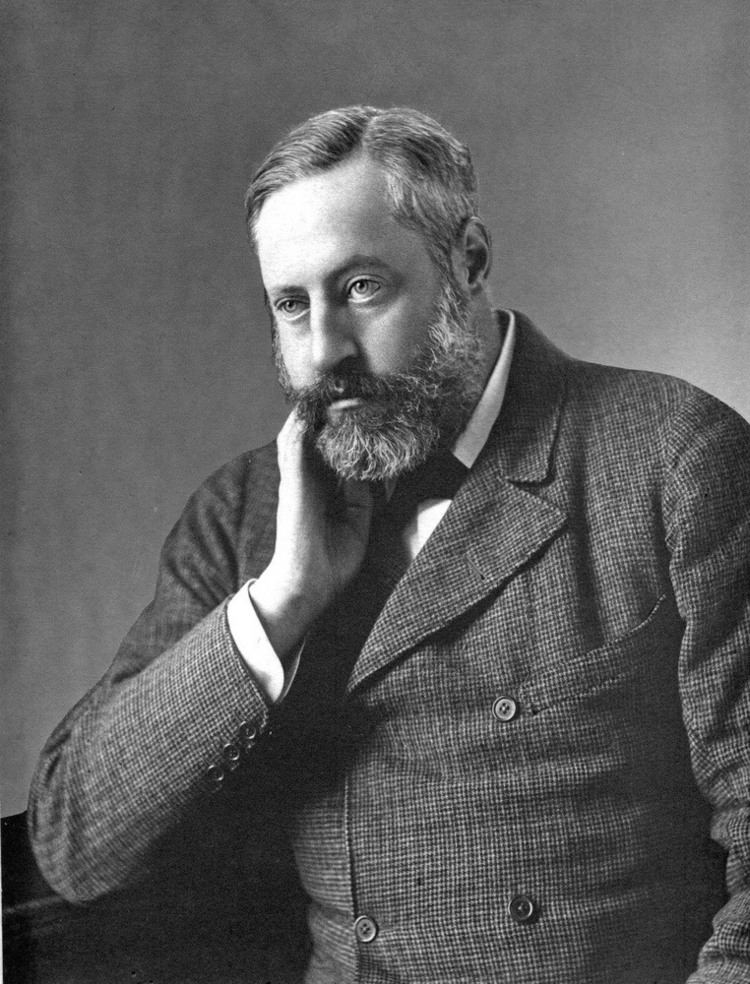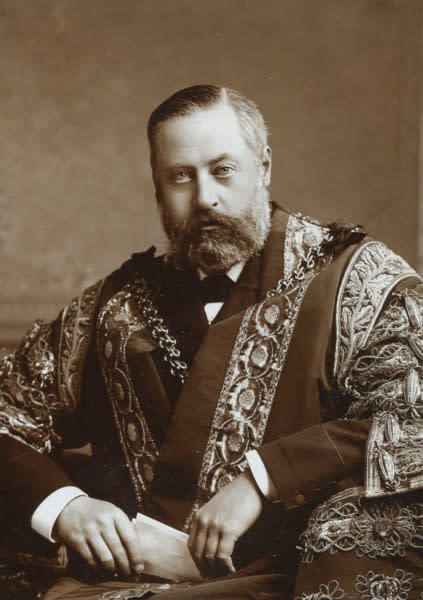Known for Philanthropy | Name John 3rd | |
 | ||
Born 12 December 1847Mount Stuart ( 1847-12-12 ) Issue John, 4th MarquessLord NinianLord ColumLady Margaret Spouse Gwendolen Fitzalan-Howard (m. 1872) Parents John Crichton-Stuart, 2nd Marquess of Bute Children Lord Ninian Crichton-Stuart, John Crichton-Stuart, 4th Marquess of Bute, Lord Colum Crichton-Stuart Books The Burning Of The Barns Of Ayr - Being The Substance Of A Lecture Given At Ayr, Feb. 7, 1878 Similar People John Crichton‑Stuart - 2nd Marq, Lord Ninian Crichton‑Stuart, John Stuart - 3rd Earl of Bute, Camilla - Duchess of Cornwall | ||
John Patrick Crichton-Stuart, 3rd Marquess of Bute KT, KSG, KGCHS (12 September 1847 – 9 October 1900) was a landed aristocrat, industrial magnate, antiquarian, scholar, philanthropist and architectural patron.
Contents
Succeeding to the marquisate at the age of only six months, his vast inheritance reportedly made him the richest man in the world. His conversion to Catholicism at the age of 21 scandalised Victorian society and led Disraeli to use the Marquess as the basis for the eponymous hero of his novel Lothair. Marrying into one of Britain's most illustrious Catholic families, Bute became one of the leaders of the British Catholic community. His enormous expenditure on building and restoration made him the foremost architectural patron of the 19th century.
Bute died at the age of only 53 in 1900 and his heart was buried on the Mount of Olives in Jerusalem. He was a Knight Grand Cross of the Holy Sepulchre, Knight of the Order of St. Gregory the Great and Hereditary Keeper of Rothesay Castle.

Early life

The Marquess was born at the family seat of Mount Stuart, on the Isle of Bute in Scotland, to John, 2nd Marquess of Bute and Lady Sophia Rawdon-Hastings (daughter of Francis, Marquess of Hastings). The Crichton-Stuarts were illegitimate offspring of the Scottish royal House of Stuart, ennobled in the 17th century. The foundations of the family's fortunes were laid by John, 3rd Earl of Bute, Prime Minister to King George III, who married an heiress, Mary Wortley-Montagu, and attained great political prominence, although this was not accompanied by great political success. His son, John, 1st Marquess of Bute, out-stripped his father by marrying two heiresses, Charlotte Hickman, daughter of the Viscount Windsor, and Frances Coutts, of the Coutts banking dynasty. By his first marriage, the Marquess fathered John Stuart who in turn fathered John, 2nd Marquess of Bute, the founder of modern Cardiff and father of the 3rd Marquess. The 2nd Marquess was a far-sighted early industrialist and began, at great financial risk, the development of Cardiff as a port to export the mineral wealth of the South Wales Valleys. Accumulating great debts and mortgages on his admittedly vast estates, the Marquess rightly foresaw the potential of Cardiff, telling his concerned solicitor in 1844, "I am willing to think well of my income in the distance." The following fifty years saw his faith triumphantly vindicated, but the ensuing riches were to be enjoyed, and spent, by his son, "the richest man in the world", rather than himself.

The 2nd Marquess died in 1848 and his son succeeded to the Marquessate when less than six months old. He was educated at Harrow School and Christ Church, Oxford. His mother died when he was nine, making him an orphan. Bute had been attracted to the Roman Catholic Church since childhood, and the efforts of his guardians to weaken this attraction only added to it. He was never a member of the Church of England, despite efforts by Henry Parry Liddon to attract him to it. Bute's letters to one of his very few intimate friends during his Oxford career show with what conscientious care he worked out the religious question for himself. On 8 December 1868, he was received into the Church by Monsignor Capel at a convent in Southwark, and a little later was confirmed by Pius IX in Rome, resulting in a public scandal. His conversion was the inspiration for Benjamin Disraeli's novel, Lothair.

Bute's eclectic early education gave him a lifelong interest in architecture, and his father's accumulated wealth was to give him the means to indulge this interest on a stupendous scale. He came to love scholarly research, and wrote on the Celtic and mediaeval periods. But it would be entirely wrong to view the 3rd Marquess as a dilettante; his interests were serious, scholarly and profound.
Interests

The Marquess's vast range of interests, which included religion, medievalism, the occult, architecture, travelling, linguistics, and philanthropy, filled his relatively short life. A prolific writer, bibliophile and traveller, as well as, somewhat reluctantly, a businessman, his energies were on a monumentally Victorian scale. "A liturgist and ecclesiologist of real distinction", he published on a wide range of topics. But at a distance, just over one hundred years from his death, it is his architectural patronage as "the greatest builder of country houses in nineteenth-century Britain" that creates his lasting memorial.
In 1865, the Marquess met William Burges and the two embarked on an architectural partnership, the results of which long outlasted Burges' own death in 1881. Bute's desires and money allied with Burges' fantastical imagination and skill led to the creation of two of the finest examples of the late Victorian era Gothic Revival, Cardiff Castle and Castell Coch. The two buildings represent both the potential of colossal industrial wealth and the desire to escape the scene of that wealth's creation. The theme recurs again and again in the huge outpouring of Bute's patronage, in chapels, castle, abbeys, universities and palaces. Bute's later buildings are hardly less remarkable than his collaborations with Burges. R R Anderson built Mount Stuart House for him, and Bute worked in collaboration with many of Burges's colleagues, including William Frame and H W Lonsdale, on the interiors. John Kinross was Bute's architect for the sympathetic and creative reworking of the partially ruined Falkland Palace. Kinross also restored Greyfriars in Elgin for Bute.
Patronage
The Marquess's patronage was extensive, with a particular enthusiasm for buildings of religion and academia. Whilst Rector of the University of St Andrews, he provided the University with a new home for its Medical School and endowed the Bute Chair of Medicine. A supporter of education for women, he also paid for St Andrews University's first female lecturer, who taught anatomy to women medical students when Professor James Bell Pettigrew refused to do so. At the University of Glasgow, he gifted the funds required to complete the University's huge central hall, named the Bute Hall in his honour, and he is commemorated both at the University's Commemoration Day and on its Memorial Gates. He was made the Honorary President ('Ceannard Urramach a' Chomainn') of the Highland Society of the University of Edinburgh.
Between 1868 and 1886 he financed the rebuilding of St Margaret's Parish Church, Roath, Cardiff, creating a new mausoleum for the Bute family with sarcophagi in red marble.
In 1866 he donated a site in Cardiff Docks for the Hamadryad Hospital Ship for sick seafarers and, on his death in 1900, bequeathed £20,000 towards the cost of a new bricks-and-mortar hospital, which became the Royal Hamadryad.
The Marquess of Bute's Case
The Marquess was involved in a notable company law case, known as "the Marquess of Bute's Case", reported on appeal in 1892, called Re Cardiff Savings Bank [1892] 2 Ch 100. The Marquess had been appointed to the board of directors of the Cardiff Savings Bank as "President", at the age of six months, in effect inheriting the office from his father. He only attended one board meeting in the next 38 years. When the bank became insolvent following a fellow director's fraudulent dealing, Stirling J held that the Marquess was not liable as he knew nothing of what was going on. It was not suggested that he ought to have known what was going on, or that he had a duty of care to inform himself as to the affairs of the bank. The case set a famous legal precedent, now superseded, for the minimal view of the duties of company directors. It was naturally a considerable embarrassment for the Marquess, although he escaped legal blame.
Family life
John, Marquess of Bute married Gwendolen Fitzalan-Howard (daughter of Edward, Lord Howard of Glossop) in 1872 and had four children:
Works
Death
Bute died in 1900 after a protracted illness [Bright's Disease], his first stroke having occurred in 1896, and was buried in a small chapel on the Isle of Bute, his ancestral home. His heart was buried on the Mount of Olives in Jerusalem.
In his will he left £100,000 to each of his children, with the exception of his eldest son, who inherited the Bute estates including Cardiff Castle and the family property on the Isle of Bute and Dumfries.
